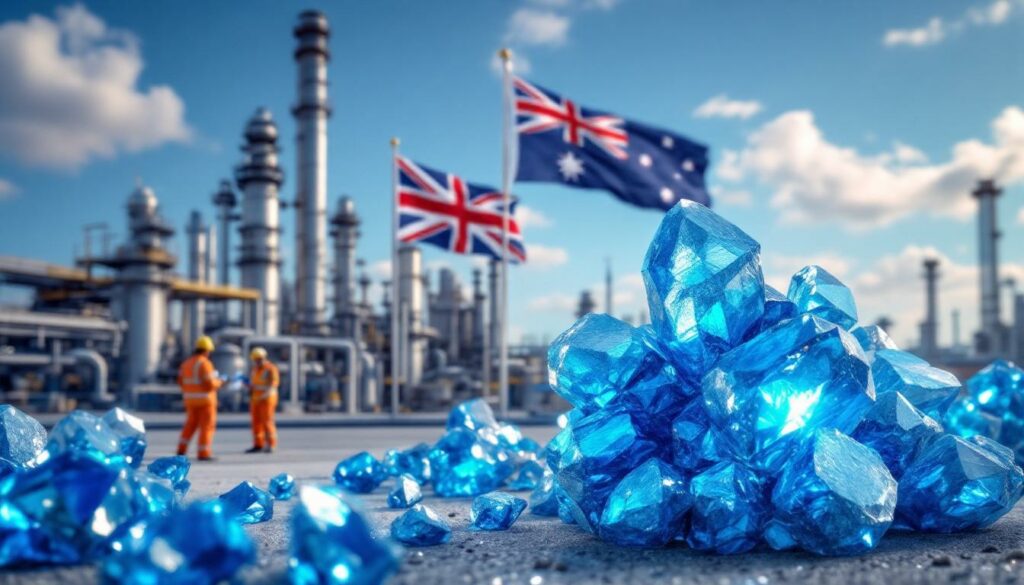Understanding the Strategic Significance of Cobalt Blue's Partnership with Glencore
Breaking Down the Landmark Supply Agreement
Cobalt Blue Holdings Ltd (ASX:COB, OTC:CBBHF) has secured a transformative feedstock supply agreement with global mining giant Glencore International, marking a critical milestone in the company's refinery development journey. This strategic partnership covers up to 50% of the cobalt hydroxide requirements for Cobalt Blue's planned Kwinana refinery, providing essential supply security.
The agreement's initial three-year term offers a solid foundation while maintaining flexibility for future extension, demonstrating both companies' commitment to establishing a long-term relationship in the critical minerals energy transition supply chain.
CEO Dr. Andrew Tong emphasized this partnership as a "critical milestone" that substantially de-risks the refinery project by securing reliable feedstock from one of the world's top-three cobalt producers.
Technical Validation Already Completed
Underscoring the partnership's practical viability, Cobalt Blue has already successfully processed a five-tonne sample of Glencore's cobalt hydroxide at its Broken Hill demonstration plant. This comprehensive testing confirmed the material's compatibility with Cobalt Blue's proprietary processing technology.
The trial successfully produced both battery-grade cobalt sulfate and high-purity cobalt metal to specification, validating the technical feasibility of the refining process with Glencore's feedstock. This technological confirmation removes a significant risk factor from the project development pathway.
How This Agreement Accelerates Cobalt Blue's Timeline
Targeting Final Investment Decision by End-2024
The Glencore supply agreement represents one of several critical milestones required before reaching Final Investment Decision (FID). With this key component secured, Cobalt Blue has established a structured development pathway with FID targeted by the end of 2024.
Remaining prerequisites include finalizing additional seed agreements, securing offtake commitments, and arranging project financing. Industry benchmarks suggest similar refinery projects typically require 18-24 months post-FID to reach production, positioning this project to potentially enter construction during a period of anticipated battery metals investment growth.
Joint Venture Structure Enhances Project Credibility
The Kwinana refinery is structured as a joint venture with Japan's Iwatani Corporation, with ownership distributed 70% to Cobalt Blue and 30% to Iwatani. This partnership brings complementary strengths in technology, market access, and financial resources.
Iwatani's substantial industrial presence in Japan and established relationships with major battery manufacturers and automotive companies strengthens the project's standing with potential customers and financiers. The 30% equity commitment demonstrates Iwatani's confidence in the project's commercial viability.
Why Cobalt Blue Has Pivoted Its Feedstock Strategy
Responding to Market Realities
Cobalt Blue initially planned to source cobalt primarily from its own Broken Hill project in New South Wales. However, persistently challenging cobalt prices (approximately $25,000/tonne in 2024) and market conditions led to a strategic pause in domestic feedstock development.
This pivot to international sourcing demonstrates management's pragmatic approach to project advancement despite market headwinds. The strategy allows development momentum to continue while maintaining the Broken Hill asset for future integration when market conditions improve.
Global Cobalt Supply Concentration
The Democratic Republic of Congo (DRC) accounted for 76% of global cobalt production in 2024, making international sourcing relationships essential for refinery operations. This geographic concentration creates both supply chain vulnerability and opportunity for diversification.
Glencore maintains significant cobalt operations in the DRC with established supply chains and responsible sourcing protocols. The partnership allows Cobalt Blue to access reliable feedstock while developing its longer-term strategy, similar to Tesla's 2023 pivot to securing Canadian cobalt sources to reduce dependency on DRC material.
Products the Kwinana Facility Will Manufacture
Dual-Stream Production Strategy
The refinery will employ a dual-product strategy, producing battery-grade cobalt sulfate (99.5% purity) for the growing energy storage and EV sectors alongside high-purity cobalt metal (99.8% purity) for specialized applications.
This approach diversifies revenue streams and reduces market exposure risk, particularly important given the volatile nature of battery material markets. The facility's design incorporates flexibility to adjust production ratios based on market conditions, optimizing returns throughout market cycles.
Strategic Market Positioning
Cobalt sulfate commands current market prices around $28,000/tonne as a critical component in lithium-ion battery cathodes, particularly for high-energy density applications where safety and performance are paramount.
Meanwhile, cobalt metal trades at a premium (approximately $35,000/tonne) in superalloy applications for aerospace, industrial turbines, and specialized tools. Defense sector applications provide stable demand less susceptible to consumer market fluctuations, with procurement policies increasingly favoring non-DRC sources.
How the Project Aligns with Battery Market Trends
Navigating EV Market Dynamics
The company acknowledges recent softening in electric vehicle demand growth rates, which slowed to approximately 15% year-over-year in 2024 compared to 40% in 2022. Despite these short-term fluctuations, the structural transition toward vehicle electrification continues to progress.
Dr. Tong noted that "long-term electrification trends remain intact" despite temporary EV market adjustments. Battery chemistry evolution continues with varying cobalt intensity across different formulations, with the refinery's design incorporating flexibility to adapt to evolving specifications including NMC 811 and LFP chemistries.
Broader Industrial Demand Resilience
Beyond batteries, cobalt demand maintains growth across multiple industrial sectors. The superalloy segment, projected to grow at a 6% CAGR through 2030, offers stable, high-margin demand less vulnerable to battery chemistry shifts.
Applications in aerospace, defense, industrial catalysts, and electronics provide market diversity that enhances the project's resilience against battery market volatility. This balanced exposure to both growth markets and established industrial applications creates a more sustainable business model.
Cobalt Blue's Immediate Focus Areas
Financing Structure Development
Cobalt Blue's current priority is advancing discussions with debt agencies, including the Australian Export Finance Agency, to secure project financing. Project finance models target a 60-70% debt-to-equity ratio, aligned with similar critical minerals projects.
The company is exploring capital raising strategies specifically designed for critical minerals processing projects. Liontown Resources' Kathleen Valley project, which secured $450 million in government-backed loans, provides a precedent for this approach in the Australian context.
Strengthening Joint Venture Collaboration
The company is working closely with Iwatani Corporation to leverage their extensive Japanese market connections, including partnerships with major industrial players like Toyota and Panasonic. This collaboration focuses on coordinating technical specifications to ensure alignment with target customer requirements.
Developing joint marketing strategies for both cobalt sulfate and cobalt metal products represents another key workstream, establishing the operational frameworks for the joint venture's governance and decision-making processes well ahead of production.
Why Kwinana Is an Ideal Location for This Facility
Strategic Infrastructure Advantages
The Kwinana industrial area hosts more than 50 industrial facilities, including BP's refinery and Tianqi Lithium's processing plant, offering established infrastructure essential for refining operations. The location's proximity to Fremantle Port (approximately 15km) enables efficient export logistics.
Western Australia Premier Roger Cook has highlighted Kwinana as "the heart of Australia's critical minerals hub," with the site benefiting from grid connection to 200MW of renewable energy sources and Western Australia's established logistics networks for both inputs and outputs.
Geopolitical and Supply Chain Security
Australia represents a politically stable jurisdiction for critical minerals processing, aligning with national strategies to develop sovereign capability in battery materials. Western Australia's established regulatory framework provides operational certainty for major industrial projects.
The location offers supply chain security advantages for customers in allied nations, particularly as Western Australia continues to expand its lithium hydroxide capacity (currently 30% of global supply) and develops green hydrogen projects in the Kwinana industrial area through companies like Fortescue Future Industries.
How This Facility Compares to Global Competitors
Key Competitive Advantages
The refinery will join only four facilities outside China and the DRC that produce cobalt sulfate at commercial scale. Australia's reputation for high environmental and social governance standards provides market differentiation, with ESG-certified cobalt commanding premiums of $2,000-$3,000 per tonne.
Analysts consistently note "Australia's geopolitical stability" as a key differentiator in critical minerals markets, particularly as the EU Critical Raw Materials Act establishes preferences for supplies from trusted jurisdictions.
Production Scale and Market Position
While production costs remain approximately $10,000/tonne higher than DRC operations, the facility's modern design incorporates zero liquid discharge (ZLD) systems that exceed EU emissions standards, similar to Umicore's ESG-linked cobalt contracts with BMW that demonstrate premium market positioning.
The facility's technology enables high recovery rates and exceptional product purity, with location advantages providing logistical benefits for serving Asia-Pacific customers who increasingly seek supply chain diversification beyond Chinese refineries.
Environmental and Sustainability Elements Incorporated
Responsible Production Design
The refinery incorporates advanced environmental controls that exceed regulatory requirements, with water recycling rates of 90% achieved in pilot testing—a critical consideration in water-conscious Western Australia. CO2 emissions are projected to be 30% lower than industry average per tonne of output.
The facility's tailings reprocessing technology converts waste streams into construction materials, demonstrating the project's alignment with UN Sustainable Development Goals (particularly SDG 9 and 12) and circular economy principles.
Ethical Supply Chain Development
The Glencore partnership includes adherence to the "Responsible Sourcing Initiative," providing customers with confidence in material provenance through transparent supply chain documentation. The company has indicated plans to participate in Initiative for Responsible Mining Assurance (IRMA) audits.
Similar to Rio Tinto's ISCC-certified cobalt from its Kennecott mine, the future potential to incorporate domestically sourced materials would further enhance the project's sustainability credentials and reduce supply chain risks associated with international sourcing.
Frequently Asked Questions About Cobalt Blue's Glencore Partnership
How does this agreement impact Cobalt Blue's financial outlook?
The Glencore agreement provides supply certainty that enhances the project's bankability. By securing a substantial portion of feedstock requirements from a major global supplier, the company reduces a key project risk factor that financiers and investors consider critical when evaluating project viability.
What happens to the Broken Hill project now?
While development of the Broken Hill project (with reserves of 82Mt at 0.08% Co) has been temporarily paused due to market conditions, it remains a valuable asset in Cobalt Blue's portfolio. Management confirms that "domestic feedstock optionality remains post-2027," potentially creating a vertically integrated operation when market conditions improve, similar to Syrah Resources' strategic approach with its Balama graphite mine.
What timeline should investors expect for project development?
Following the targeted Final Investment Decision by end-2024 and completion of the bankable feasibility study anticipated in Q3 2024, construction and commissioning would likely extend 24 months, suggesting potential production by 2026-2027, subject to financing arrangements and regulatory approvals.
How will the refinery be financed?
The company is pursuing a multi-faceted financing strategy including debt facilities from export credit agencies, strategic partner investments, and government support mechanisms designed for Cobalt Blue expansion projects. While this approach minimizes immediate shareholder dilution, investors should consider potential future equity raises and their impact on ownership structure.
What role does the Iwatani partnership play in project success?
Beyond their 30% equity contribution, Iwatani brings technical expertise in chemical processing, established relationships in Japanese industrial markets, and strategic alignment with Japan's battery supply chain development goals. The partnership also enables exploration of innovative offtake prepayment structures commonly used in battery metals investment projects to reduce upfront capital requirements.
Disclaimer: This article contains forward-looking statements regarding project development timelines, market projections, and financial outcomes. Actual results may differ materially from these projections due to market conditions, technical challenges, or other factors beyond the company's control. Investors should conduct their own due diligence before making investment decisions.
Ready to Discover the Next Major ASX Mining Opportunity?
Stay ahead of the market with Discovery Alert's proprietary Discovery IQ model, which instantly identifies significant mineral discoveries like cobalt and battery metals on the ASX before they make headlines. Explore why major discoveries can lead to exceptional returns by visiting the Discovery Alert discoveries page.




